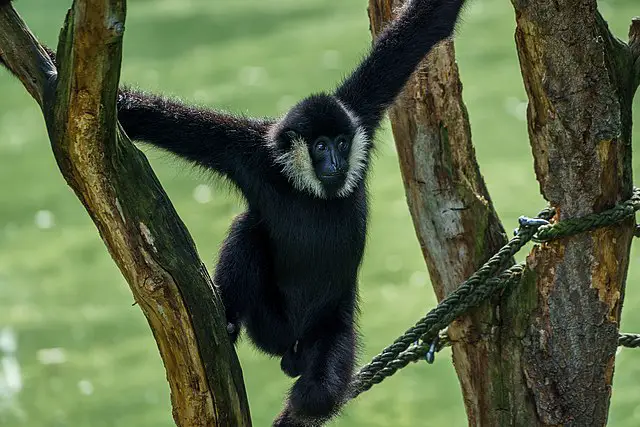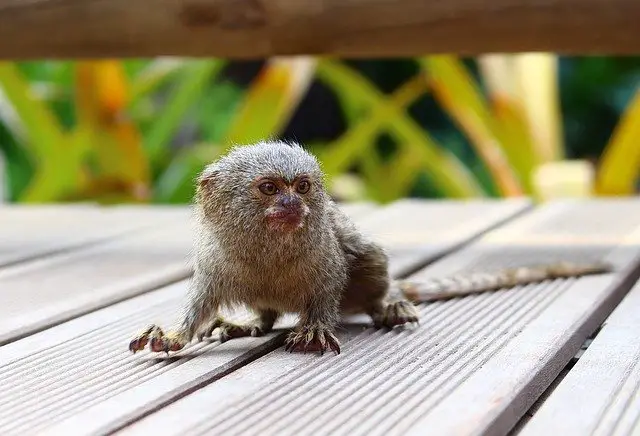Here are the top 10 Spider Monkey Facts For Kids which will provide you with a brief overview about this amazing monkey.
- The spider monkeys are the most intelligent of all the New World monkeys as per recent studies.
- They are called spider monkeys because they often hang upside down from a tree or branch with their tail just like a spider.
- Their tail is longer than their body and they use it like a fifth limb.
- There are seven species of spider monkey.
- Their lifespan is 20 to 27 years in the wild.
- They mostly eat fruits and nuts.
- They are found in tropical rainforests of South and Central America.
- They form loose groups of usually 15 to 25 individuals which are led by females.
- They communicate by making various types of voices and postures.
- All the species of spider monkey are under threat and their population is declining.
As you can see from the above spider monkey facts that, it is an amazing monkey. Continue reading till the end of this page to learn All About Spider Monkey.
Spider Monkey Facts For Kids
What Is A Spider Monkey
- Spider monkeys is a group of New World monkeys that belongs to the genus Ateles.
- There are seven species of spider monkeys.
- All the species inhabit the tropical forests of South and Central America.
- Recent studies (based on the meta-analysis of primate cognition) indicates that spider monkeys are the most intelligent of all the New World monkeys.
- All the species are under threat, two species are critically endangered, four are endangered, and one is vulnerable on the IUCN Red List.
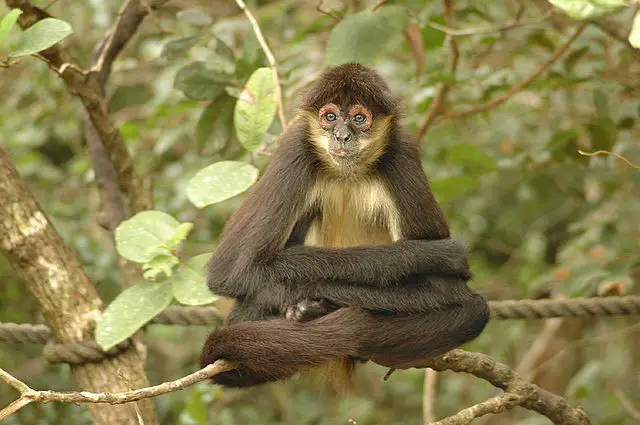
What Does A Spider Monkey Look Like – Show Me Spider Monkeys
- A spider monkey has large and thin limbs, small head, short body, and a long prehensile tail.
- Male individuals of the largest species (black-headed spider monkeys) have an average body weight of 11 kg and body-size between 16 and 22 inches.
- They have long hair of black, brown, or grey color at their back and of white color at their belly.
How Did Spider Monkeys Get Their Name – What Does Spider Monkey Mean
- Spider monkeys got the name “Spider Monkey” because of their long and thin limbs, short body, and their ability to use their tail as an extra limb.
- They often hang upside down from a tree or branch merely with their tail while all their limbs dangle, just like a spider hangs only with its silk.
What Is The Scientific Name For Spider Monkey – Spider Monkey Scientific Name
The scientific name of all the species of spider monkeys are:
- Ateles belzebuth
- Ateles chamek
- Ateles hybridus
- Ateles marginatus
- Ateles fusciceps
- Ateles geoffroyi
- Ateles paniscus
Spider Monkey Taxonomy
- The following is the scientific classification or taxonomy of the spider monkey:
| Kingdom | Animalia |
| Phylum | Chordata |
| Sub-phylum | Vertebrata |
| Class | Mammalia |
| Order | Primates |
| Sub-order | Haplorhini |
| Infra-order | Simiiformes |
| Family | Atelidae |
| Subfamily | Atelinae |
| Genus | Ateles |
| Species |
|
Spider Monkey Genus Name
- The genus name of the spider monkey is “Ateles”.
How Big Is A Spider Monkey – Spider Monkey Size
- The largest spider monkey species is considered as the Black-headed spider monkey, which has an average body size of up to 19 inches (49 cm).
- The head and body size of the red-faced spider monkey is up to 21.9 inches (55.7 cm).
- White-bellied spider monkey has a body size between 13 to 23 inches (33 to 58 cm).
- Peruvian spider monkeys have up to 24 inches (60 cm) body size.
- Brown spider monkeys have up to 20 inches (50 cm) body size.
- White-cheeked spider monkeys have about 47 inches total size.
- The size of Geoffroy’s spider monkey is between 12 and 25 inches (30 to 63 cm).
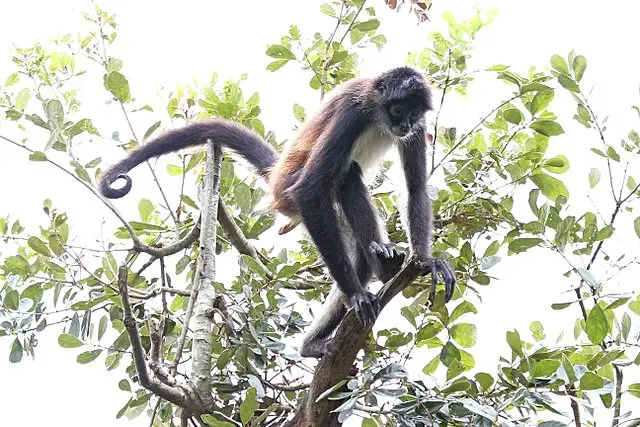
How Tall Is A Spider Monkey – Spider Monkey Height
- The average height of an adult male spider monkey is 1.83 feet (21.96 inches) and of an adult female is 1.81 feet (21.72 inches).
- In the following table, the height of all the seven species of spider monkeys is shown:
| Species | Height (inches) |
| Black-headed spider monkey | 15 to 21 |
| Red-faced spider monkey | 16 to 24 |
| Black-faced spider monkey (Peruvian spider monkey) | 22 |
| White-bellied spider monkey | 13.39 to 23.23 |
| Brown spider monkey | 20 |
| White-cheeked spider monkey | 39 |
| Geoffrey’s spider monkey | 12 to 25 |
How Much Does A Spider Monkey Weigh – Spider Monkey Weight
- The weight of all the seven spider monkey species is shown in the following table:
| Species | Weight (kg) | Weight (Ib) |
| Black-headed spider monkey | 8.9 | 19.5 |
| Red-faced spider monkey | 8.4 and 9.1 | 19 to 20 |
| Black-faced spider monkey (Peruvian spider monkey) | 7 to 9 | 15.42 to 19.82 |
| White-bellied spider monkey | 5.9 to 10.4 | 13.0 to 22.9 |
| Brown spider monkey | 7.9 and 9.1 | 17 and 20 |
| White-cheeked spider monkey | 8.3 kg | 18.3 |
| Geoffrey’s spider monkey | 6 to 9 | 13 to 20 |
Spider Monkey Features
The following are some of the major features of spider monkeys:
- Spider monkeys have a buff (light brownish yellow), golden, red, brown, or black color fur and usually black hands and feet.
- They have small heads and no hair on their faces.
- One of the spider monkeys’ distinguishing features is their broad nose and very far apart nostrils.
- They have relatively small bodies and long narrow limbs, due to which they look like spiders.
- All species have a long prehensile tail (usually longer than their bodies), which serves as an extra limb.
- Unlike other monkeys, they do not rely on their limbs for balance when walking and use their tails for this purpose.
- They have hook-like narrow hands, long and recurved fingers, and reduced or non-existent thumbs.
- Spider monkeys are extremely agile, and are believed to be second after gibbons in this quality.
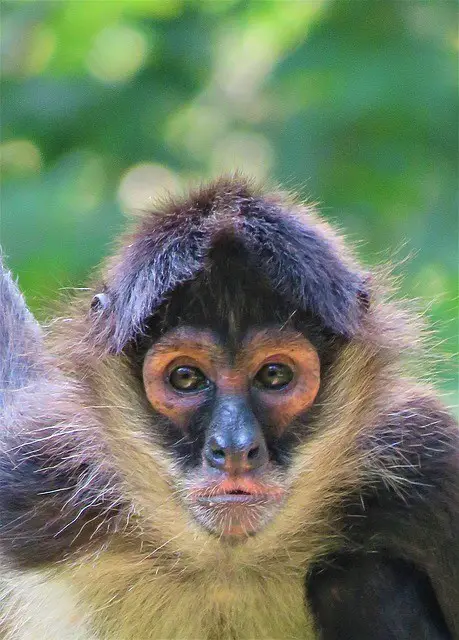
Spider Monkey Feet
- Spider monkeys have two feet like other primates.
- Every foot has five fingers and elongated shape.
- They use their feet for walking from tree to tree.
Spider Monkey Fingers
- Unlike other primates, the hands of spider monkeys have reduced thumbs or even lack the opposable thumbs.
- Their hands have four fingers.
- All the fingers are elongated and recurved, which give a hook-like appearance to their hands.
Spider Monkey Tail
- Spider monkeys have extremely flexible and prehensile tails.
- Their tail reaches up to 35 inches in length, which may be longer than their body.
- Their tails also have skin grooves and hairless tips that resemble fingerprints.
- When walking from tree to tree, they depend on their tail for balance.
- They use their tail as a fifth limb in their arboreal lifestyle.
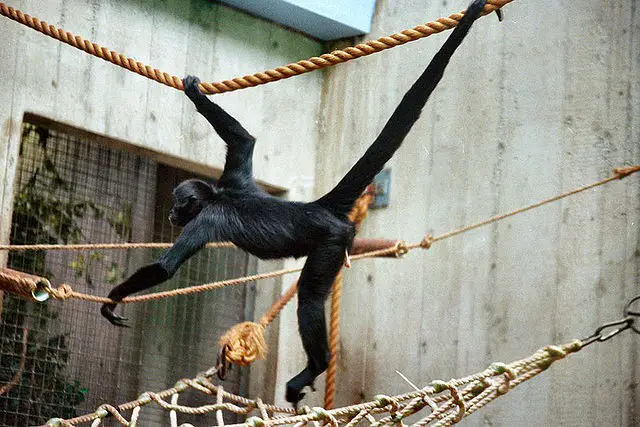
How Long Do Spider Monkeys Live – Spider Monkey Lifespan
- Spider monkeys live for 20 to 27 years in the wild.
- In captivity, they live for up to 35 years.
- The oldest living spider monkey in captivity is probably Gummy, who was born in 1962 in the wild and is currently residing at Fort Rickey Children’s Discovery Zoo in Rome, NY, USA.
What Makes A Spider Monkey Unique From Other Monkeys
- Some features make spider monkeys unique from other monkeys. Such as:
- A long prehensile tail and its use as an extra limb
- Lack of opposable thumbs in the hands
- Highly agility
- Large size of brain
Spider Monkey Species – Types Of Spider Monkeys
There are seven species or types of spider monkeys, that are:
- White-fronted or white-bellied spider monkey (Ateles belzebuth)
- Peruvian spider monkey or black-faced spider monkey (Ateles chamek)
- Brown spider monkey (Ateles hybridus)
- White-cheeked spider monkey (Ateles marginatus)
- Black-headed spider monkey (Ateles fusciceps)
- Geoffroy’s spider monkey (Ateles geoffroyi)
- Red-faced spider monkey (Ateles paniscus)
What Do Spider Monkeys Eat – Spider Monkey Diet
- Spider monkeys eat fruits and nuts as 70 to 85% of their diet.
- They can survive for a long period while eating only one or two types of fruits.
- They eat fruits as a whole and excrete seeds in feces, that is why they play a vital role in seed dispersal.
- Their feeding time is usually from dawn to 10 am, however, they may also eat infrequently during the rest of the day.
- They forage in the high canopy layer of the rainforest at an altitude of about 82 to 98 feet (25 to 30 meter).
- In case of food scarcity, they eat leaves, tree bark, honey, bird eggs, and insects.
- They get their food in a unique way, in which a leading female has the responsibility to find food sources for the group. If she does not find enough food for the whole group, she will split the group into smaller groups that separately forage.
- Studies reveal that the diet of spider monkeys cause changes to their reproductive, physical, and social behavioral patterns.
Where Do Spider Monkeys Live – Spider Monkey Habitat
- All the species of spider monkeys inhabit the tropical rainforests of South and Central America.
- Every species of spider monkeys have a slightly different preference of habitat.
- They are found in evergreen rainforests, mangrove and semi-deciduous forests, lowland rainforests, and mountain forests.
- Some species prefer to live in undisturbed forests.
- All the species prefer to live in wet forests and usually avoid dry forests.
- In rainforests, spider monkeys inhabit the upper layers of the trees and forage in the high canopy where they have less competition for food.
- Spider monkeys avoid to live in the upper layer of canopy. Possibly, the thin branches of the upper parts of the trees do not support the monkeys’ weight that is why they avoid it.
- They have a strictly arboreal lifestyle and usually avoid walking on the forest floor.

Why Do Spider Monkeys Live In The Rainforest
- Spider monkeys live in the rainforests because they are well adapted to this type of habitat.
- Their long prehensile tail and hook-like hands allows them to gracefully swing and walk from tree to tree.
- In the rainforest, they also found a large variety of food to survive.
Spider Monkeys Biome
- Spider monkeys are found in the “Tropical Rainforest” type of biome.
Where Are Spider Monkeys Found – Spider Monkey Location – Spider Monkey Range
- Spider monkeys are found in the tropical rainforests of South and Central America.
- Their habitat range is from southern Mexico to Brazil.
- The current location of the seven species is:
- White-fronted or white-bellied spider monkeys (Ateles belzebuth) are found in Columbia, Peru, Venezuela, Ecuador, Brazil, and the northeastern portion of Amazon in South America.
- Peruvian spider monkeys or black-faced spider monkeys (Ateles chamek) are found in Bolivia, Peru, and Brazil.
- Brown spider monkeys (Ateles hybridus) are found in Venezuela and Columbia.
- White-cheeked spider monkeys (Ateles marginatus) are found only in Brazil.
- Black-headed spider monkeys (Ateles fusciceps) are found only in Columbia.
- Geoffroy’s spider monkeys (Ateles geoffroyi) are found in Guatemala, Costa Rica, Brazil, and Panama.
- Red-faced spider monkeys (Ateles paniscus) are found in Venezuela, French Guiana, Guyana, Suriname, and Brazil.
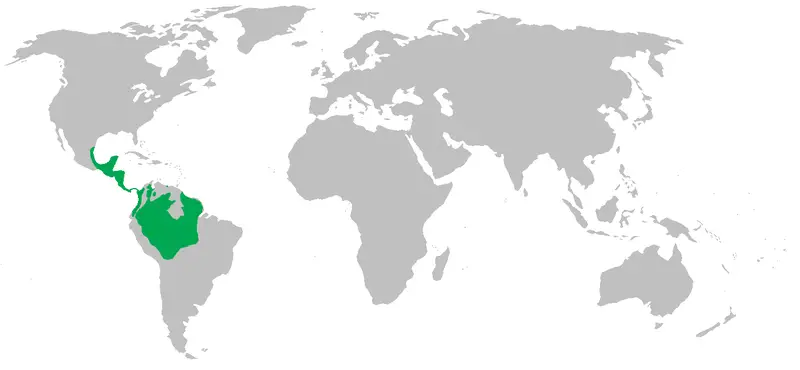
Spider Monkey Reproduction
- Male spider monkeys sexually mature at the age of five years while females mature at the age of four years.
- Spider monkeys reproduce once after every three to four years.
- Other sources say that the females reproduce once every 17 to 45 months.
- The female selects a male from her group to mate.
- Their gestation period is from 226 to 232 days.
- The average number of offsprings every female bears is only one.
- Mothers totally care for their babies and feed them with their own milk.
- The babies are weaned at the age of about 2 years.
Male Spider Monkey
- Male spider monkeys have a very slightly larger size than females.
- They have an average body weight of 11 kg (24 pounds) and an average body size of about 21 inches.
- Males do not involve in the care of offspring.
- Male spider monkey is one of the few primate species, in which the baculum (penis bone) is absent.
Female Spider Monkey
- Female spider monkeys have a slightly smaller body size than their male counterparts.
- They have an average body weight of 9.66 kg (21.3 pounds) and an average body size of about 20 inches.
- Females have a complete responsibility of raising the offspring.
- In spider monkeys, a female rather than male leads the group to find food sources.
Spider Monkey Baby
- Baby spider monkeys are born after the gestation period of 226 to 232 days.
- After birth, a baby completely depends on its mother for food and protection.
- For the first month of its life, the mother carries it around her belly.
- After that, the baby rides on the lower back of its mother.
- The baby usually grabs its mother’s midsection tightly and wraps its tail around its mother’s tail for more protection.
- A baby spider monkey completely depends on its mother until the age of six to ten months.
- Mothers grooms their babies and helps them to navigate from tree to tree.
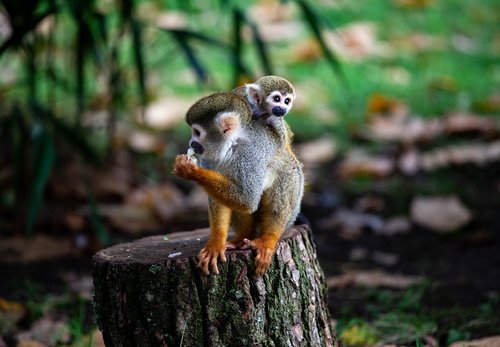
Spider Monkey Behavior – What Do Spider Monkeys Do
- Spider monkeys are social animals and form loose groups of usually 15 to 25 individuals. However, a group may have sometimes up to 30 or 40 individuals. In day time, the groups split up into subgroups. The average size of a subgroup is between 2 and 8 individuals. However, it may sometimes have up to 17 individuals.
- When the young spider monkeys reach puberty, the females rather than males disperse to join new groups. While males tend to remain united for their whole lives. This behavior is less common in primates.
- Spider monkeys use different stances and postures to communicate their observations and intentions. For example, postures of attack and sexual receptivity. When they see an approaching human, they start loud barking like a dog and growl threateningly. To scare away an approaching monkey, a spider monkey climbs to a branch’s end and shakes it vigorously.
- If a pursuer continues approaching, then a spider monkey often breaks off up to 4 kg heavy dead or live tree branches and throws them towards the pursuer. A spider monkey actually does not throw the branch, but twists the branch and causes it to drop near the threat. Spider monkeys also urinate and defecate towards the pursuer.
- Spider monkeys are also diurnal; remain active during the day and sleep at night.
- It is believed that a leading female directs the group of spider monkeys. She also has the responsibility to plane for an efficient feeding route every day.
Where Do Spider Monkeys Sleep
- Spider monkeys carefully choose trees to sleep during the night.
- They sleep in groups and select the trees where they feel secure and safe from predators.
Are Spider Monkeys Aggressive – Angry Spider Monkey – Spider Monkey Dangerous
- Spider monkeys look lovely and harmless.
- However, they become aggressive when approached in the wild.
- They urinate and defecate towards the approacher and throw tree branches towards them.
- When kept in captivity in isolation, they develop mental problems due to which they bite and harm people.
Spider Monkey Adaptations
Spider monkeys are well adapted to their arboreal lifestyle. The following are their major adaptations:
-
Skull Structure
- All species of spider monkeys have round and small skulls relative to their body size. Their eyes are positioned in the forward direction, which makes them able to exactly gauge the distances when swaying from one tree to another.
-
Brain Size
- A spider monkey has a double size brain as compared to howler monkey of equal body size.
- It is believed that spider monkeys adapted a large-sized brain due to their complex social system and frugivorous diet, which basically consists of a wide variety of ripe fruits (more than 150 species).
- This needed the monkeys to have a good memory, so that they can remember that the fruits can be found where and when.
-
Thin and Long Arms
- Spider monkeys have long, thin and strong arms that are well adapted for their arboreal lifestyle.
- It allows them to easily swing and climb when moving among trees.
-
Absence of the Thumbs
- All species of spider monkeys lack thumbs and have only four fingers in their hands.
- They have long and recurved fingers like a hook that provide them a strong grip on branches during climbing and swinging.
-
Long and Prehensile Tail
- Spider monkeys have long (usually longer than their body length), muscular, and prehensile tail, which they used as an extra limb.
- The underside of their tail lack hair and is well-adapted for holding and grasping.
- Spider monkeys often hang down from a tree or branch only with their tail. This ability makes them highly agile and allows them to move fastly and easily between trees and branches.
-
Complex Social System
- Spider monkeys exhibit complex social behaviors.
- They live in groups, which are led by the leading females.
- They forage and sleep in groups to stay safe from predators.
- They communicate by making various types of voices and postures.
How Many Spider Monkeys Are Left In The World – Spider Monkey Population
- The exact population of all the spider monkey species is unknown. However, according to the IUCN Red List, all the species are under threat and their population trend is declining.
- It is estimated that the population of black-headed spider monkey species have decreased by 30% in the last 45 years.
- In the last 50 years, the population of white-bellied spider monkey and Peruvian spider monkey species have decreased by approximately 50%.
- Brown spider monkey species is one of “The World’s 25 Most Endangered Primates”. It is estimated that the population of this species has declined by 80%. While some of their populations have already become locally extinct.
- In 2008, it was estimated that the population of white-cheeked spider monkeys declined by 50% during the course of three generations.
Why Are Spider Monkeys Endangered
Spider monkeys are endangered because of:
-
Habitat loss
- Loss of habitat is an extremely serious threat to the survival of spider monkeys.
- They are frequently losing their habitat due to human activities, such as deforestation for timber and to get land for the development of livestock and agriculture.
- In some regions, highways are passed through their habitats that also causes a serious disturbance.
- The habitat range of some species is also destroyed and polluted due to illegal mining activities, such as in the Peruvian region of Madre de Dios.
-
Hunting by humans
- Spider monkeys are excessively hunted for bushmeat trade and pet trade.
- In Brazil, spider monkeys are considered as a delicacy by some of the indigenous people.
-
Hunting by predators
- Large carnivore animals found in their habitat, such as jaguars, pumas, and ocelots are also a threat to their survival, as spider monkeys have a low reproductive rate.
What Eats Spider Monkeys – Spider Monkeys Predators
The following animals are the major natural predators of spider monkeys:
- Jaguars
- Pumas
- Large snakes
- Ocelotes
- Eagles
- Hawks
- Besides these animal species, human beings are the biggest predators of spider monkeys.
Spider Monkey Movie
- “Return of the spider monkeys” is a 2016 movie about a spider monkey named “Infinity”.
- She was stolen from a forest in Guatemala when she was a baby.
- It is the story of her seven year rehabilitation and then return to the Maya rainforest.
- The movie exhibits what happens when spider monkeys are released back into their natural habitat in the wild.
Spider Monkey As A Pet – Baby Spider Monkey Pet
- Keeping a spider monkey as a pet is not suitable.
- They need special care as they become aggressive and violent after reaching sexual maturity.
- When domesticated alone, a spider monkey develops mental problems that cause them to bite and harm people.
How To Buy A Spider Monkey
- There are many private breeders who sell spider monkeys.
- One can find it on the internet.
How Much Does A Spider Monkey Cost – Spider Monkey Prices
- A spider monkey cost is around $6,000.
- On some websites, the price of baby male spider monkeys is $14,000.


